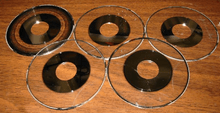Deskstar
The Deskstar is the name of a product line of computer hard disk drives. It was originally announced by IBM in October 1994.[1] The line was continued by Hitachi when in 2003 it bought IBM's hard disk drive division and renamed it Hitachi Global Storage Technologies. In 2012 Hitachi sold the division to Western Digital who rebranded it as HGST.
The first Deskstar product produced by IBM was the DALA-3540; the last was the 180GXP[1] HGST continued the product line after the acquisition, selling the Deskstar 120GXP and Deskstar 180GXP under the HGST brand for a short time and selling new models thereafter.
The unreliable IBM Deskstar 75GXP product became notorious as the "Deathstar" (only one of at least twenty IBM products in the Deskstar family)[2]
Products
A list of all Deskstar models, including those manufactured by both IBM and HGST
IBM models
- Deskstar DALA-3540
- Deskstar DALS-3540 (SCSI)
- Deskstar DJAA-31270/31700
- Deskstar DSAA-3270/3360/3540/3720
- Deskstar DSAS-3270/3360/3540/3720 (SCSI)
- Deskstar XP
- Deskstar 3
- Deskstar 4
- Deskstar 5
- Deskstar 8
- Deskstar 14GXP
- Deskstar 16GP
- Deskstar 22GXP
- Deskstar 25GP
- Deskstar 34GXP
- Deskstar 37GP
- Deskstar 40GV
- Deskstar 75GXP
- Deskstar 60GXP
- Deskstar 120GXP
- Deskstar 180GXP
Hitachi GST models
- Deskstar 120GXP
- Deskstar 180GXP
- Deskstar 7K80
- Deskstar 7K160
- Deskstar 7K250
- Deskstar T7K250
- Deskstar 7K400
- Deskstar 7K500
- Deskstar E7K500
- Deskstar T7K500
- Deskstar 7K1000
- Deskstar P7K500
- Deskstar 7K1000.B
- Deskstar E7K1000
- Deskstar 7K2000
- Deskstar 7K1000.C
- Deskstar 5K1000
- Deskstar 7K3000
- Deskstar 5K3000
- Deskstar 5K1000.B
- Deskstar 7K1000.D
- Deskstar 5K4000
- Deskstar 7K4000
HGST models
- Deskstar 5K1000.B
- Deskstar 7K1000.D
- Deskstar 5K4000
- Deskstar 7K4000
IBM Deskstar 75GXP failures
The IBM Deskstar 75GXP (six models ranging in capacity from 15 to 75 GB) became infamous circa 2001 for their reportedly high failure rates.[3][4] This led to the drives being colloquially referred to as "Deathstars".[5] Due to this, the drives were ranked 18th in PC World's "Worst Tech Products of All Time" feature in 2006.[6][7] Note the simultaneously announced IBM Deskstar 40GV, a 5400 RPM version of the 7200 RPM 75GXP, did not suffer from the same reported high failure rate.
Lawsuit
Despite failures being reported within the manufacturer warranty period of three years, Michael T. Granito, Jr., an American user of IBM's 75GXP hard drives, filed a class-action lawsuit against IBM on 16 October 2001 for defects in the product causing it to "crash", with both of the drives he'd bought having failed within a short time.[8] IBM was found to have misled its customers about the reliability of the drives. Without admitting responsibility, they settled this lawsuit in 2005, agreeing to pay $100 to every user whose Deskstar 75GXP drives had failed.[9] The settlement related to the following family of IBM Deskstar 75GXP HDD models: DTLA 307-015; DTLA 307-020; DTLA 307-030; DTLA 307-045; DTLA 307-060; DTLA 307-075;[10] the Deskstar 40GV was not included in the litigation.
Details

The drives were known for an unusually high rate of head crashes, due to the magnetic coating soon beginning to loosen and sprinkle off from the platters, creating dust in the hard disk array and leading to crashes over large areas of the platters. The combination of two technologies, GMR (Giant Magneto-Resistive) heads on 3.5-inch glass platters, are said to be largely to blame for the issues.[11]
A firmware update introduced wear levelling which avoids the heads dwelling too long over the same area thereby reducing the potential for head crashes.[12] The same firmware update also fixed a possible data corruption due to a problem with S.M.A.R.T. background operations.[13]
Aftermath
After the filing of lawsuit, IBM unveiled the Deskstar 120GXP, and the Travelstar 60GH and 40GN on November 7, 2001.[14] The Deskstar documentation was updated to show that the drives had been rated to 333 power-on hours per month (45 percent), leading to speculation that this was the result of the lawsuit. However, an IBM spokesperson replied that the rating was not new at the time.
See also
References
- 1 2 Bob Francis (October 17, 1994). "IBM's disk drive family has three new members". Infoworld: 40.
- ↑ http://forums.storagereview.com/index.php/topic/11454-fix-for-ibm-75gxp-60gxp-and-120gxp
- ↑ Computer History Museum article on IBM 75GXP “Deskstar,” failures
- ↑ CNet review of the IBM Deskstar 75GXP
- ↑ Spotlight on IBM Deathstar Again
- ↑ Dan Tynan (26 May 2006), "The 25 Worst Tech Products of All Time", PC World.
- ↑ Users Complain About IBM's Crashing Drives
- ↑ IBM hit with hard drive class action suit
- ↑ Hard Drives: Recovery
- ↑ http://web.archive.org/web/20060315210759/http://www.ibmdeskstar75gxplitigation.com/faqs.asp#Q4 What is a “Qualifying Deskstar 75GXP”
- ↑ MR heads on 2.5-inch glass platters had been reliably shipping for many years prior to the introduction of the Deskstar.
- ↑ http://forums.storagereview.com/index.php/topic/11454-fix-for-ibm-75gxp-60gxp-and-120gxp/
- ↑ https://web.archive.org/web/20040202105912/http://www.geocities.com/dtla_update/
- ↑ http://www-03.ibm.com/press/us/en/pressrelease/1022.wss
External links
- IBM Deskstar 75GXP Class Action Website on Internet Archive
- Official HGST Deskstar Page
- Dead deathstar dissected The loss of recording layer from the glass platters is clearly shown.